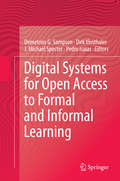 Digital Systems for Open Access to Formal and Informal Learning
1399152
Digital Systems for Open Access to Formal and Informal Learning
1399152
|
Dirk Ifenthaler
J. Michael Spector
Pedro Isaias
Demetrios G. Sampson
|
9783319022642 |
2014 |
Contains images
|
|
 Digital T Level: Digital Support Services and Digital Business Services (Core)
6213117
Digital T Level: Digital Support Services and Digital Business Services (Core)
6213117
|
Sonia Stuart
Maureen Everett
|
9781398344839 |
2022 |
Contains images
|
|
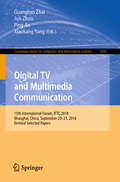 Digital TV and Multimedia Communication: 15th International Forum, IFTC 2018, Shanghai, China, September 20–21, 2018, Revised Selected Papers (Communications in Computer and Information Science #1009)
2573973
Digital TV and Multimedia Communication: 15th International Forum, IFTC 2018, Shanghai, China, September 20–21, 2018, Revised Selected Papers (Communications in Computer and Information Science #1009)
2573973
|
Jun Zhou
Xiaokang Yang
Guangtao Zhai
Ping An
|
9789811381386 |
2019 |
Contains images
|
|
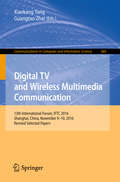 Digital TV and Wireless Multimedia Communication
1538013
Digital TV and Wireless Multimedia Communication
1538013
|
Xiaokang Yang
Guangtao Zhai
|
9789811042119 |
2017 |
Contains images
|
|
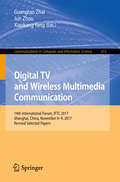 Digital TV and Wireless Multimedia Communication
1907343
Digital TV and Wireless Multimedia Communication
1907343
|
Jun Zhou
Xiaokang Yang
Guangtao Zhai
|
9789811081088 |
2018 |
Contains images
|
|
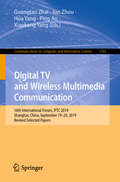 Digital TV and Wireless Multimedia Communication: 16th International Forum, IFTC 2019, Shanghai, China, September 19–20, 2019, Revised Selected Papers (Communications in Computer and Information Science #1181)
3407753
Digital TV and Wireless Multimedia Communication: 16th International Forum, IFTC 2019, Shanghai, China, September 19–20, 2019, Revised Selected Papers (Communications in Computer and Information Science #1181)
3407753
|
Jun Zhou
Xiaokang Yang
Guangtao Zhai
Ping An
Hua Yang
|
9789811533419 |
2020 |
Contains images
|
|
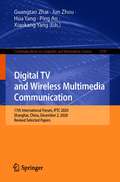 Digital TV and Wireless Multimedia Communication: 17th International Forum, IFTC 2020, Shanghai, China, December 2, 2020, Revised Selected Papers (Communications in Computer and Information Science #1390)
3951657
Digital TV and Wireless Multimedia Communication: 17th International Forum, IFTC 2020, Shanghai, China, December 2, 2020, Revised Selected Papers (Communications in Computer and Information Science #1390)
3951657
|
Jun Zhou
Xiaokang Yang
Guangtao Zhai
Ping An
Hua Yang
|
9789811611940 |
2021 |
Contains images
|
|
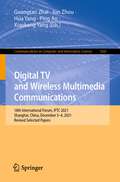 Digital TV and Wireless Multimedia Communications: 18th International Forum, IFTC 2021, Shanghai, China, December 3–4, 2021, Revised Selected Papers (Communications in Computer and Information Science #1560)
4553579
Digital TV and Wireless Multimedia Communications: 18th International Forum, IFTC 2021, Shanghai, China, December 3–4, 2021, Revised Selected Papers (Communications in Computer and Information Science #1560)
4553579
|
Jun Zhou
Xiaokang Yang
Guangtao Zhai
Ping An
Hua Yang
|
9789811922664 |
2022 |
Contains images
|
|
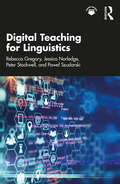 Digital Teaching for Linguistics
4376877
Digital Teaching for Linguistics
4376877
|
Peter Stockwell
Paweł Szudarski
Rebecca Gregory
Jessica Norledge
|
9781000534832 |
2022 |
Contains images
|
|
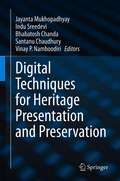 Digital Techniques for Heritage Presentation and Preservation
3959866
Digital Techniques for Heritage Presentation and Preservation
3959866
|
Jayanta Mukhopadhyay
Santanu Chaudhury
Bhabatosh Chanda
Vinay P. Namboodiri
Indu Sreedevi
|
9783030579074 |
2021 |
Contains images
|
|
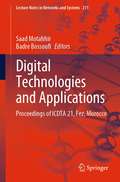 Digital Technologies and Applications: Proceedings of ICDTA 21, Fez, Morocco (Lecture Notes in Networks and Systems #211)
4179777
Digital Technologies and Applications: Proceedings of ICDTA 21, Fez, Morocco (Lecture Notes in Networks and Systems #211)
4179777
|
Saad Motahhir
Badre Bossoufi
|
9783030738822 |
2021 |
Contains images
|
|
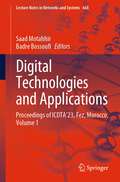 Digital Technologies and Applications: Proceedings of ICDTA'23, Fez, Morocco, Volume 1 (Lecture Notes in Networks and Systems #668)
5316448
Digital Technologies and Applications: Proceedings of ICDTA'23, Fez, Morocco, Volume 1 (Lecture Notes in Networks and Systems #668)
5316448
|
Saad Motahhir
Badre Bossoufi
|
9783031298578 |
2023 |
Contains images
|
|
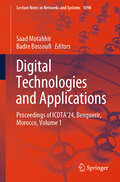 Digital Technologies and Applications: Proceedings of ICDTA'24, Benguerir, Morocco, Volume 1 (Lecture Notes in Networks and Systems #1098)
6146459
Digital Technologies and Applications: Proceedings of ICDTA'24, Benguerir, Morocco, Volume 1 (Lecture Notes in Networks and Systems #1098)
6146459
|
Saad Motahhir
Badre Bossoufi
|
9783031686504 |
2024 |
Contains images
|
|
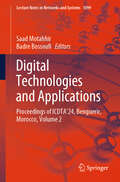 Digital Technologies and Applications: Proceedings of ICDTA'24, Benguerir, Morocco, Volume 2 (Lecture Notes in Networks and Systems #1099)
6462834
Digital Technologies and Applications: Proceedings of ICDTA'24, Benguerir, Morocco, Volume 2 (Lecture Notes in Networks and Systems #1099)
6462834
|
Saad Motahhir
Badre Bossoufi
|
9783031686535 |
2024 |
Contains images
|
|
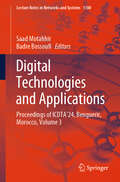 Digital Technologies and Applications: Proceedings of ICDTA'24, Benguerir, Morocco, Volume 3 (Lecture Notes in Networks and Systems #1100)
6323574
Digital Technologies and Applications: Proceedings of ICDTA'24, Benguerir, Morocco, Volume 3 (Lecture Notes in Networks and Systems #1100)
6323574
|
Saad Motahhir
Badre Bossoufi
|
9783031686603 |
2024 |
Contains images
|
|
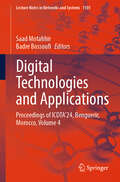 Digital Technologies and Applications: Proceedings of ICDTA'24, Benguerir, Morocco, Volume 4 (Lecture Notes in Networks and Systems #1101)
6197842
Digital Technologies and Applications: Proceedings of ICDTA'24, Benguerir, Morocco, Volume 4 (Lecture Notes in Networks and Systems #1101)
6197842
|
Saad Motahhir
Badre Bossoufi
|
9783031686757 |
2024 |
Contains images
|
|
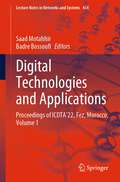 Digital Technologies and Applications: Proceedings of ICDTA’22, Fez, Morocco, Volume 1 (Lecture Notes in Networks and Systems #454)
4541111
Digital Technologies and Applications: Proceedings of ICDTA’22, Fez, Morocco, Volume 1 (Lecture Notes in Networks and Systems #454)
4541111
|
Saad Motahhir
Badre Bossoufi
|
9783031019425 |
2022 |
Contains images
|
|
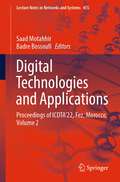 Digital Technologies and Applications: Proceedings of ICDTA’22, Fez, Morocco, Volume 2 (Lecture Notes in Networks and Systems #455)
4736837
Digital Technologies and Applications: Proceedings of ICDTA’22, Fez, Morocco, Volume 2 (Lecture Notes in Networks and Systems #455)
4736837
|
Saad Motahhir
Badre Bossoufi
|
9783031024474 |
2022 |
Contains images
|
|
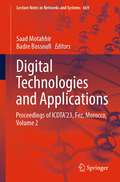 Digital Technologies and Applications: Proceedings of ICDTA’23, Fez, Morocco, Volume 2 (Lecture Notes in Networks and Systems #669)
5322405
Digital Technologies and Applications: Proceedings of ICDTA’23, Fez, Morocco, Volume 2 (Lecture Notes in Networks and Systems #669)
5322405
|
Saad Motahhir
Badre Bossoufi
|
9783031298608 |
2023 |
Contains images
|
|
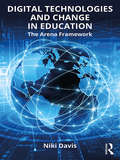 Digital Technologies and Change in Education: The Arena Framework
2510786
Digital Technologies and Change in Education: The Arena Framework
2510786
|
Niki Davis
|
9781317270324 |
2018 |
Contains images
|
|
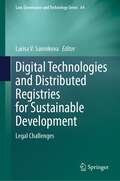 Digital Technologies and Distributed Registries for Sustainable Development: Legal Challenges (Law, Governance and Technology Series #64)
5930186
Digital Technologies and Distributed Registries for Sustainable Development: Legal Challenges (Law, Governance and Technology Series #64)
5930186
|
Larisa V. Sannikova
|
9783031510670 |
2024 |
|
|
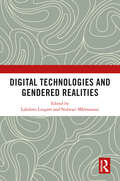 Digital Technologies and Gendered Realities
6174651
Digital Technologies and Gendered Realities
6174651
|
Lakshmi Lingam and Nolwazi Mkhwanazi
|
9781040124987 |
2025 |
Contains images
|
|
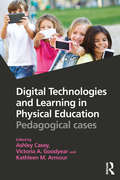 Digital Technologies and Learning in Physical Education: Pedagogical cases
5567982
Digital Technologies and Learning in Physical Education: Pedagogical cases
5567982
|
Ashley Casey, Victoria A. Goodyear and Kathleen M. Armour
|
9781317366287 |
2017 |
Contains images
|
|
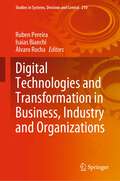 Digital Technologies and Transformation in Business, Industry and Organizations (Studies in Systems, Decision and Control #210)
4892324
Digital Technologies and Transformation in Business, Industry and Organizations (Studies in Systems, Decision and Control #210)
4892324
|
Álvaro Rocha
Ruben Pereira
Isaias Bianchi
|
9783031076268 |
2022 |
Contains images
|
|
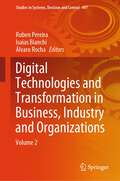 Digital Technologies and Transformation in Business, Industry and Organizations: Volume 2 (Studies in Systems, Decision and Control #497)
5750670
Digital Technologies and Transformation in Business, Industry and Organizations: Volume 2 (Studies in Systems, Decision and Control #497)
5750670
|
Álvaro Rocha
Ruben Pereira
Isaias Bianchi
|
9783031407109 |
2023 |
Contains images
|
|